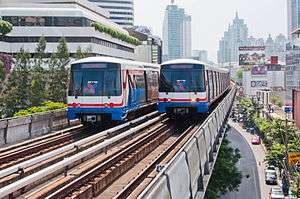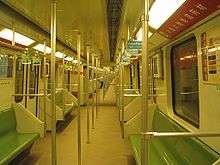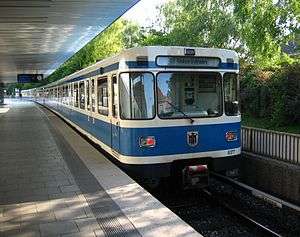Siemens Modular Metro
The Siemens Modular Metro is a family of electric multiple unit trains for rapid transit systems produced by Siemens Transportation Systems and used by rail operators around the world. The vehicle concept was launched in Vienna in 2000 and is a modular concept allowing many variants of metro vehicles.[1] Previously known as Modular Mobility, Siemens, whose rail equipment division has been renamed Siemens Mobility, still uses the abbreviation Mo.Mo[2][3]; however, these trains are no longer being made, having been replaced by Siemens's new Inspiro family of metro trainsets.

.jpg)
Technology
The train is designed for use on systems in the 20,000 to 60,000 passengers/hour range. The design of the train bodies is by Porsche Design. Modules in the system include various vehicle ends, doors, gangways, roof-mounted air-conditioning, and interiors.[1] Many combinations of motor cars and trailers are possible, with individual vehicle lengths from 17 to 25 metres (55 ft 9 in to 82 ft 0 in) and widths from 2.6 to 3.2 metres (8 ft 6 in to 10 ft 6 in). Stainless steel or aluminium construction is available, in three cross sections: straight sidewalls, sidewalls sloping at 3 degrees, and contoured.[1]
Operators
- Bangkok MRT Blue Line: each train consists of two motor cars and a centre trailer car.[4]
- Bangkok BTS Skytrain Light and Dark Green Line: 35 three-car units, each train consist of two motor cars and two center trailer cars.
- Kaohsiung Mass Rapid Transit, Kaohsiung, Taiwan
- Taipei Metro's C321 and C341 trainsets, used on Bannan Line
- Nuremberg U-Bahn Line U2 and U3: designated DT3, 30 two-car driverless trains, 36m long, 2.9m wide with an inter-car gangway. 80 seats and room for 240 standing passengers.[5]
- Metro Trains Melbourne Northern Group and Caufield Group Lines: designated 'Siemens' trains, 72 three car sets from 2003.[6]
- Shanghai Metro: 28 six-car modular trains for Line 4, 10 trains for an extension of Line 1. First two trains in Vienna, remainder built in China.[7]
- Oslo Metro: designated MX3000, 115 three-car units.
- Guangzhou Metro : 21 six-cars modular trains which build with Adtranz for line 1,120 cars which is based on it for line 3.
- Vienna U-Bahn: designated Type V, 6-car units.
 First official Mo.Mo train, the Vienna U-Bahn Type V
First official Mo.Mo train, the Vienna U-Bahn Type V- Inside view of Vienna U-Bahn Type V
 Version of the Siemens Modular Metro as used on the Railways in Melbourne
Version of the Siemens Modular Metro as used on the Railways in Melbourne- Internal features of the Nuremberg Fully Automatic DT3
 MX3000 trains in Oslo
MX3000 trains in Oslo Interior of Mo.Mo train in Bangkok Metro
Interior of Mo.Mo train in Bangkok Metro Mo.Mo train in BTS Skytrain Bangkok
Mo.Mo train in BTS Skytrain Bangkok Shanghai Mo.Mo was designed in Germany, but built in China
Shanghai Mo.Mo was designed in Germany, but built in China Inside the Shanghai Mo.Mo
Inside the Shanghai Mo.Mo- Guangzhou Mo.Mo in Guangzhou Metro line 1
Design Origins
The bodies of the trains evolved from the 1993 DT2 Series used in the Nuremberg U-Bahn whose design in turn came from production of the A Series built for the nearby Munich U-Bahn, but now also used in Nuremberg.
 The Nuremberg DT2 from 1993 was a precursor to the Modular Metro designs
The Nuremberg DT2 from 1993 was a precursor to the Modular Metro designs Interior of the DT2
Interior of the DT2 The Munich U-Bahn A Series appeared in 1967, influencing later metro designs
The Munich U-Bahn A Series appeared in 1967, influencing later metro designs
References
- "New Vehicle Concept Launched In Vienna". International Railway Journal. September 2000. Retrieved 2008-08-30.
- Metro System for Bangkok, Thailand Turnkey Project Siemens
- Siemens tries MoMo concept 1999-07-01, Railway Gazette International
- "Bangkok's first underground metro open". International Railway Journal. July 2004. Retrieved 2008-08-30.
- Mike Knutton (August 2002). "First U-Bahn to convert to fully automatic operation". International Railway Journal. Retrieved 2008-08-30.
- "VICSIG: Siemens trains". www.vicsig.net. Retrieved 2008-08-30.
- "Siemens, Alstom win Chinese transit contracts". Railway Age. findarticles.com. May 2002. Retrieved 2008-08-30.
External links
| Wikimedia Commons has media related to Siemens Modular Metro. |
- Siemens MoMo flyer - 'The City needs Mobility'
- Porsche Design portfolio